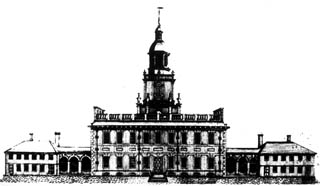London in Miniature

Independence Hall as it looked to the delegates to the Continental Congress in 1776. This engraving appeared as an inset on John Reed's "Map of Philadelphia and Vicinity" of 1774, republished by Charles L. Warner in 1870. Park historians and architects consider it the most accurate 18th century view of the building. It shows the original tower, taken down in 1871, and the flanking wings, larger than the reconstructions erected in 1896. Linking the hall and the wings are enclosed arcades, with staircases giving access to the second floor wings. Click for an enlargement
Fifty years later, the delegates to the First and Second Continental Congresses arrived in a Philadelphia that could no longer be called a town, but had become a city. "Philadelphia," an English visitor wrote as early as 1755, "is London in miniature." By 1774 Philadelphia, with a population approaching 25,000, had surpassed Boston as the western hemisphere's largest port, and was, indeed, the second largest city in the English-speaking world. To its advantages of size and wealth were added those of location, midway between the northern and southern colonies, and political moderation. It was the obvious place for the representatives of the colonies to assemble to discuss common concerns and debate a course of action.
With the agricultural wealth of Pennsylvania and southern New Jersey passing through their storehouses, Philadelphia's merchants had become rich through trade with the other colonies, the West Indies, and Europe. The city reflected their wealth. Philadelphia had become a city predominantly of brick dwelling houses, which a French visitor admired because they "display a regular and noble appearance superior to that of our French houses." The finest houses were on Front and Second Streets, although no street was entirely residential. On Front Street the merchants maintained their whole-sale operations, and Second Street was the fashionable shopping area, which "at midday with its crowds of pedestrians and its variety of elegant shops presents a sight that one wishes might be seen on the Rue Saint Honore."
The city boasted a number of amenities. Many of the streets were paved with cobbles taken from the Delaware River at Trenton and were supplied with flagstone cartways and gutters. There were brick sidewalks, some streetlights, a night watch, and several fire companies. Although the open squares provided in the original plan had not yet been landscaped, large private gardens provided the welcome relief of greenery. Delegates such as John Adams also visited, and were impressed by, the city's public buildings, including a jail and a hospital. Of course Carpenters' Hall, at the end of its alley off Chestnut Street between Third and Fourth, was well known to the delegates who met there in 1774. The State House, site of the momentous deliberations of 1776, dominated the block of Chestnut between Fifth and Sixth Streets. It was undoubtedly the most impressive public building in the colonies, with the mass of its main building topped by a lofty bell tower and joined to the lower flanking office buildings by arcades containing handsome staircases.
There was much to be admired, and Adams found that the "Regularity and Elegance of this City are very striking." Nevertheless, the atmosphere of the city was not entirely pleasant. In the 1770s Dock Creek was still an open sewer west of Third Street, and there were several tanneries along its banks, one behind Carpenters' Hall. When the delegates sat in the State House in the summer of 1776, they could hardly have been unaware of the slaughter-house across Fifth Street between the back of the Norris garden and Walnut Street.



